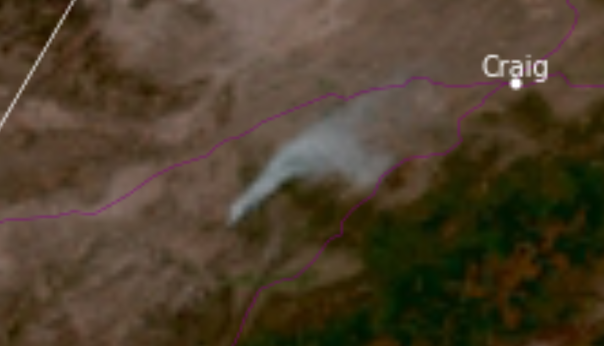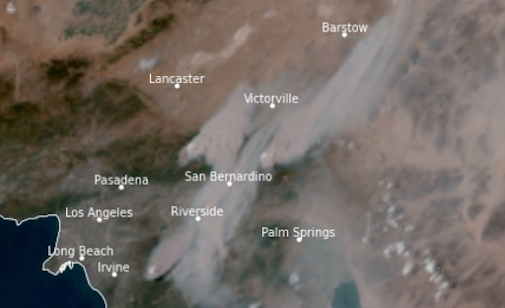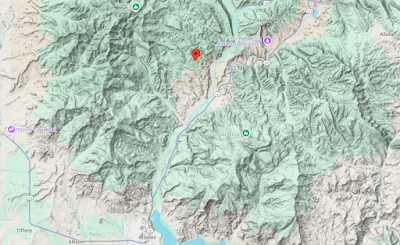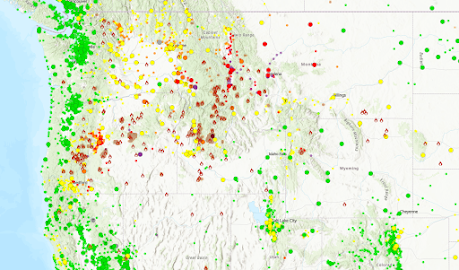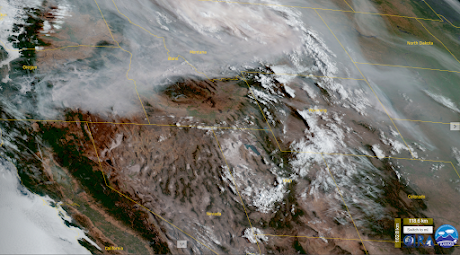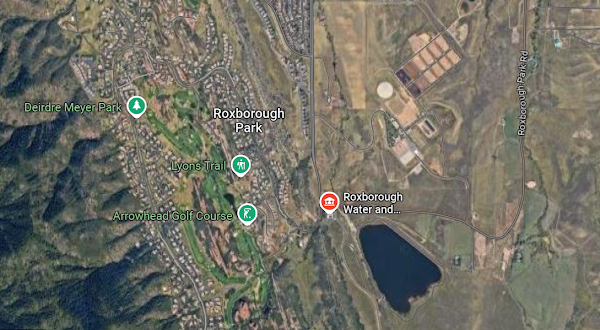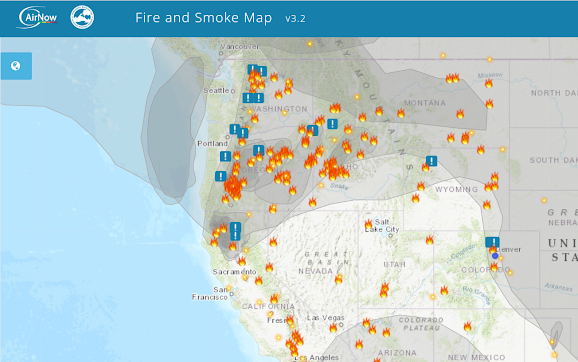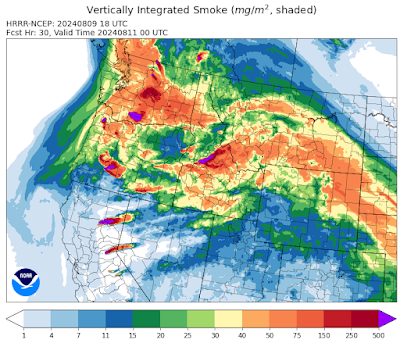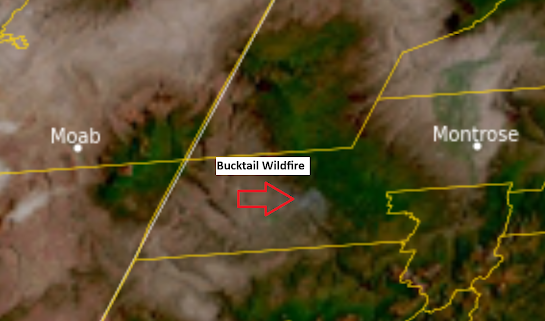The Pearl wildfire is burning in northern Larimer County about 5 miles to the northwest of Red Feather Lakes. Mandatory evacuations have been issued so please do heed local officials and emergency response personnel if you are in the area. Smoke concerns should be minimized due to the population being moved out and the fire's relatively small size (approximately 138 acres as of 4:10 PM MDT). However, brief periods of heavy smoke will be possible throughout the area due to the gusty and erratic winds anticipated through this evening.
Colorado Smoke Blog
The CDPHE Air Pollution Control Division periodically updates this page to provide information about smoke in Colorado. This page covers wildfire activity, prescribed burning operations, and the transport of smoke from out-of-state sources.
Si desea solicitar interpretación al español, envíe un mensaje por correo electrónico a cdphe_apcd_outreach@state.co.us
Accessibility statement and support
Monday, September 16, 2024
New wildfire start in Larimer County
Saturday, September 14, 2024
Northwestern Colorado wildfire
A wildfire is located near the Moffat/Rio Blanco county line. Fortunately it is isolated and in a remote area, so should cause no public health impacts. However you may see some smoke if you are travelling on State Highway 13 between Craig and Meeker.
Friday, September 13, 2024
Light to moderate smoke will linger in Colorado on Friday with gradual clearing, 9/13/24
Smoke from wildfires in the western U.S. has made its way into Colorado, but thankfully, concentrations seen across the state have remained fairly tolerable. Fine particulate monitors throughout the state show good to moderate air quality, with much of the residual smoke being seen in the central mountains and along the Front Range.
Thursday, September 12, 2024
Smoke expected to move into Colorado Thursday, into Friday... but how much? 9/12/24
Models continue to indicate that smoke from fires across the western U.S. will move into Colorado Thursday evening and into Friday, however, so far the timing and severity of those impacts has not aligned with the model's predictions. It is suspected that cloud cover and increased relative humidity within the cooler air mass that is moving through the northwest states has limited fire activity, and breezy winds are helping to disperse smoke more effectively than the model is able to account for.
This is NOT to say that the threat of smoke moving into Colorado does not remain, it is simply to underscore the uncertainty of the timing and overall impact of this influence.
An uptick in particulate counts has been seen in in western Colorado, including in Grand Junction, where monitors are showing Moderate air quality. However the conditions seen to the west and southwest remain less concerning than anticipated.
This is all very encouraging for the moment, but does not mean that we are totally in the clear. The conditions seen in areas closest to the many fires in other states confirm that smoke is still being produced, and is still likely to move toward Colorado Thursday night, and may settle in by Friday morning.
Those who are sensitive to exposure to smoke should continue to reduce heavy exertion and take precautionary measures to reduce negative health impacts from smoke. You can find information about potential health complications and ways to reduce exposure on CDPHE's website, or by clicking on the Health Information tab at the top of this blog page.
We will continue to monitor conditions closely, and will report significant changes and expectations as they emerge.
Smoke arriving Thursday from large wildfires upwind of Colorado, 9/12/24
The smoke expected to infiltrate Colorado from areas to the west and northwest of our state has begun to arrive. Folks in western and southwestern Colorado have woken up to hazy skies, and monitors are already showing Moderate concentrations of fine particulates.
Map from fire.airnow.gov shows Moderate air quality conditions creeping into Colorado, with higher levels of particulates to the west.As model depictions, satellite observations, and ground monitors help us to track the movement and impact of this smoke, more information (possibly including Air Quality Health Advisories) will be posted here. Stay tuned for mor information as the situation develops.
Wednesday, September 11, 2024
Another increase of wildfire smoke appears to be on the way
We are closely monitoring wildfires in states to the west of Colorado as the meteorological conditions are looking increasingly favorable (or unfavorable, depending on how you look at it) for smoke concentrations to increase across Colorado over the next 24-48 hours.
Let's start with wildfires in southern California. Up to this point this summer, southern California wildfires have not had much impact on our air quality here in Colorado. However, that may soon change.
Smoke from these wildfires is already hanging over Nevada, Arizona and Utah. With southwesterly winds aloft, this smoke will likely be pushed over western Colorado by Wednesday evening. That smoke will likely stay up in the atmosphere Wednesday night and not cause any issues, but bigger changes are more likely to occur on Thursday. As the atmosphere heats up during the day on Thursday, some of that smoke will likely mix down to the surface across western Colorado. Meanwhile, a very strong upper level low pressure system is going to shift the upper level winds over the southern California wildfires from northwesterly to southwesterly which will transport additional smoke in the direction of Colorado.
How much smoke will Colorado receive on Thursday? That is still unclear at this point. The good news is that it should be a pretty breezy day across much of the state which should limit smoke from accumulating too much at the surface of the earth, but we should anticipate hazy skies and at least some moderate concentrations of smoke (especially across the northern and western halves of Colorado).
Unfortunately, it is not only the southern California wildfires that may have an impact on our air quality. Long duration wildfires in Oregon and Idaho may also make their presence known by Thursday night. The good news is that smoke should impact a smaller section of Colorado, generally the northwestern part of the state. But that smoke could no doubt be noticeable by Friday morning in places like Craig, Rangely, and Meeker.
You can get more information on wildfires throughout the western US at InciWeb.
So we do advise Coloradoans throughout the state to keep checking this blog and remain up-to-date on the latest information as conditions continue to evolve. Although health advisories are not necessarily imminent, residents who are especially sensitive to wildfire smoke (asthma, COPD, etc.) should start making preparations now to limit exertion and outdoor activity starting Thursday and continuing into Friday. You can learn more about ways to protect your health at our wildfire smoke and health webpage.
Looking on the bright side, the storm system that will transport this smoke into Colorado will also bring a cooler and less dry air mass to the wildfire locations upwind. We are hopeful that air mass change will decrease the fire activity and smoke production, which in turn would decrease the threat of poor air quality in Colorado in the days and weeks ahead.
Tuesday, September 10, 2024
Possible Smoke Tuesday Afternoon
Large wildfires continue to burn in Oregon, Idaho, and Montana, and heavy smoke persists. While Colorado's air is comparatively clean, the northern Front Range may see some smoke this afternoon.
The HRRR-Smoke model shows a brief uptick of smoke in eastern Colorado arriving Tuesday afternoon. By noon, The Northern Front Range may begin to see smoke. Throughout the afternoon, smoke is expected to move south. The highest chance of smoke will be north of the Palmer Divide. Smoke is likely to dissipate by Wednesday.
No major public health impacts are expected, but those with asthma or other respiratory ailments may consider reducing prolonged or heavy exertion today.
Monday, September 9, 2024
Prescribed fires expected this week
As we head into the autumn months and the threat for wildfires decreases, expect to see an increase in prescribed fire activity across the state. This is especially true with larger landscape burns that often occur during the early autumn months before the snow starts to fly.
This week, some sizable broadcast burns are expected in the southwestern part of Colorado. The US Forest Service will be conducting a 1000+ acre burn today between Chimney Rock and Arboles (see map below). Due to the remote location of this burn, public health impacts are not anticipated. However smoke will likely be visible today on that section of State Highway 151. You can find more details on this burn and additional information from the San Juan National Forest at InciWeb. The southwest district of the Bureau of Land Management will also be conducting prescribed burns this month in southwestern Colorado.
Please be sure to stay up-to-date on all the larger burns that will be conducted across Colorado over the coming months by clicking the Prescribed Fire Map tab above. You can view all the current smoke management permits for this calendar year along with weekly burn notifications.
Heaviest smoke continues to avoid Colorado
The EPA's Fire and Smoke Map and GOES-18 visible satellite image (see below) show exactly where the active wildfires and heavy smoke are located. Colorado has been fortunate in recent weeks with the vast majority of that smoke remaining north of the state. The question becomes, how long will our luck hold out? The good news is that, at least in the short-term, the really heavy smoke will remain north and northwest of Colorado. However, that does not mean that we will remain completely unscathed. In fact, a quick smoke intrusion is looking increasingly likely for the northeastern corner of Colorado on Tuesday. This would include the northern Front Range region (Ft. Collins, Boulder, Denver) along with the adjacent plains (Julesburg, Sterling). So expect increasingly hazy skies in this part of Colorado on Tuesday along with elevated levels of particle pollution. We are not expecting major health impacts at this time, but if you do suffer from heart/lung disease you may want to take this into account if you do plan on spending time outdoors on Tuesday. More information can be found on our wildfire smoke and health webpage.
GOES-18 visible satellite image shows heavy smoke originating from wildfires in Oregon, Idaho and Montana
Friday, September 6, 2024
Light smoke lingers in Colorado, likely to continue through the weekend, 9/6/24
While wildfire activity remains pleasantly quiet in Colorado and fine particulate levels continue to be in the Good to Moderate range, our neighbors to the north and west are still contending with areas of thick smoke from fires in Wyoming and Idaho. The heaviest smoke remains in the areas close to the fires, blanketing central Idaho and northwestern Wyoming.
Thursday, September 5, 2024
Potential for smoke moving into eastern Colorado, 9/5/24
For the moment, Colorado is enjoying clean air while neighboring states are experiencing elevated levels of fine particulates due to the transport of wildfire smoke.
Little in the way of public health impacts are expected, and concentrations are expected to remain light to moderate. However areas of haze are possible, especially in northeastern portions of the state. Keep an eye on conditions in your area and those who are sensitive to smoke exposure may consider health precautions in areas where smoke becomes apparent.
Light concentrations may linger on Friday morning, however the large-scale wind flow pattern looks to limit additional transport on Friday. Potential for incoming smoke returns on Saturday, and updates on expectations will be posted here as the situation evolves.
Tuesday, September 3, 2024
Possible Smoke Arriving Midweek
Large fires in Idaho continue to produce heavy smoke, some of which may reach Colorado this week. Smoke could begin to move into eastern Colorado starting on Wednesday. Eastern Colorado may notice haze and light smoke, beginning Wednesday and continuing through Thursday.
No major public health impacts are expected, but CDPHE is monitoring the situation and will issue an Air Quality Health Advisory if it becomes necessary.
Sunday, September 1, 2024
Light Smoke Lingering Through Labor Day
Smoke from out-of-state wildfires made its way to Colorado on Friday. Sunday morning, smoke is lingering on the Front Range and in northern Colorado.
This morning, many monitors are reporting Moderate Particulate Matter. As atmospheric mixing kicks in Sunday afternoon, smoke concentrations should decrease. Although no major public health impacts are expected from this smoke, unusually sensitive people may consider reducing prolonged or heavy exertion today.
The HRRR-Smoke model suggests that light smoke and hazy skies may linger through Monday.
Friday, August 30, 2024
Here Comes the Smoke
Smoke has begun to make its way into Colorado this morning. Satellite imagery shows light smoke in northwest Colorado and on the Front Range. Fortunately for Colorado, the heaviest smoke is upwind in Wyoming, Utah, and Idaho.
In northwestern Colorado, particularly Moffat County, light smoke and haze may be noticeable this morning. Smoke is expected to dissipate as atmospheric mixing increases this afternoon.
On the Front Range and eastern Plains, smoke may continue to mix down to the surface throughout the day. The HRRR-Smoke model shows light smoke developing Friday afternoon. In southeast Colorado, there may be noticeable haze and light smoke.
No major public health impacts are expected, but you may consider taking steps to protect your health from wildfire smoke today. If conditions worsen, CDPHE will issue an Air Quality Health Advisory.
Thursday, August 29, 2024
Potential Smoke on Friday
As of Thursday morning, the anticipated potential smoke hasn't panned out. No major fires broke out in Wyoming yesterday, so Colorado is currently in the clear.
Friday, smoke may return for some of the state. Smoke from the large fires burning in Idaho is expected to move south into Wyoming, Utah, and parts of Colorado beginning overnight Thursday night through Friday morning. Northwestern Colorado may wake up to hazy skies and light smoke. On the Eastern Plains, haze and light smoke are possible as well.
At this time, no major public health impacts are expected. CDPHE is monitoring the situation and will issue an advisory if necessary.
Wednesday, August 28, 2024
Potential Smoke at the End of This Week
Smoke may be back in the picture this week. While there are still many uncertainties, northern Colorado may experience smoke beginning Thursday.
A Red Flag Warning is in effect for much of Wyoming. As of this morning, the fires in Wyoming are mostly contained, but any new fire starts could spread quickly. Northerly winds are expected to develop on Thursday morning, meaning any smoke from these potential fires could reach northern Colorado.
The HRRR-Smoke model indicates that smoke from Idaho could move into northern Colorado by Friday morning. It is still too early to tell with certainty which locations will be most impacted, but CDPHE will continue to monitor and update the smoke blog as this week progresses.
Tuesday, August 27, 2024
Brush fire near Roxborough Park
A brush fire is burning near the Denver Water treatment plant in Roxborough Park. There are no immediate air quality health concerns but please avoid the area and we will continue to monitor the situation.
Thursday, August 22, 2024
Smoke moving into northern Colorado on Thursday from out-of-state fires, 8/22/24
Wildfire activity in Colorado remains relatively quiet, and thankfully smoke impacts from the Goltra fire near Golden are very minimal on Thursday morning.
However, fires in Wyoming (and other upwind states) remain active, and winds out of the north have drawn smoke into northern Colorado. Monitors on the EPA's fire and smoke map show recent, significant increases in particulate levels in Greeley and the surrounding areas. As these conditions persist during the daytime hours on Thursday, smoke may move into other areas including northern portions of the east plains, as well as along the Front Range, potentially affecting Fort Collins, Longmont, Denver, and areas in-between.
Wednesday, August 21, 2024
Goltra Fire burning in Jefferson County
The Goltra Fire is burning in Jefferson County approximately 1 mile west of Golden. The fire is estimated at 200 acres as of Wednesday morning.
Purple Air sensors downwind of the fire show elevated particulate concentrations this morning. Light smoke and hazy skies are possible in Golden and north Denver throughout Wednesday. Visit CDPHE's website for information on how to protect your health during periods of wildfire smoke.
Rain and high relative humidity are expected Wednesday which could aid firefighting efforts, and limit air quality impacts.
CDPHE is monitoring the situation and will issue an Air Quality Health Advisory if necessary.
Tuesday, August 20, 2024
Where's the smoke?
After a very smoky July, August has been relatively clear. There are two reasons for the clear skies and clean air this week.
Thursday, August 15, 2024
Potential Smoke Arriving Thursday and Friday
Wednesday, August 14, 2024
Out--of-state wildfire smoke possible on Thursday for northeastern Colorado
There's still plenty of wildfire activity across the northwestern United States, but thankfully the smoke from those fires has largely avoided Colorado for the past several days. That might be about to change. Although we are not anticipating heavy smoke at this time, there is certainly the possibility that particle pollution could be elevated on Thursday across the northeastern corner of Colorado, including Julesburg, Ft. Morgan, and Akron. By Thursday afternoon and evening, some of that smoke may reach the northern Front Range region of Denver, Boulder and Ft. Collins. Stay tuned.
Friday, August 9, 2024
Smoke may be around this weekend, but limited amounts are expected near the surface, 8/9/24
There is a bit of 'a tale of two levels (of the atmosphere)' to be told for the upcoming weekend. Fires in California and the Pacific Northwest continue to be active and produce plenty of smoke, which is likely to be transported eastward. However, much of that smoke is expected to remain aloft, in upper portions of the atmosphere, and is also expected to mostly stay to the northern areas of the western U.S., resulting in minimal surface impacts in Colorado. the images below, from the HRRR-Smoke model show the large plumes of smoke coming from the states to our west and northwest, and also show the great differences in the amounts of smoke that are expected to be found throughout the atmosphere (top) vs amounts expected near the surface (bottom).
Thursday, August 8, 2024
Light to Moderate smoke possible in areas of northwestern Colorado on Thursday, 8/8/24
We are glad to be reporting about the air quality impacts due to smoke in Colorado with a far lower sense of alarm than has been seen recently! However we always want to keep everyone alert to all situations that may influence public health, so we continue to monitor fires in Colorado, and those in up-wind states that may produce smoke impacts here.
The Bucktail Fire in Montrose County has remained fairly quiet, not showing significant heat or smoke production, and has allowed advisories and commentary to be unnecessary. We continue to monitor conditions in the area, although information on this fire remains sparse. We will provide updates as needed if things change in this area.
The Big Gulch fire in Moffat County (~15 miles west of Craig) increased in reported size between Wednesday and Thursday, yet this incident also has not shown significant heat or air quality impacts on Thursday. Most of the smoke seen in NW Colorado likely originated from fires that are out-of-state and is being transported into Colorado, however light concentrations of smoke emanating from the Big Gulch fire may be contributing to the yellow color of monitors shown on the fire and smoke map from airnow.gov. This indicates Moderate air quality due to fine particulates in northwestern Colorado.
Wednesday, August 7, 2024
More Smoke Coming for Colorado
Northwestern Colorado could experience another shot of smoke starting tonight.
Smoke models show smoke advancing into northwestern counties as early as Wednesday night, and continuing throughout the day Thursday. Smoke from fires in Canada and the Pacific Northwest could advance into northwestern Colorado, as a cold front moves in from the north.
Residents in Moffat, Routt, Jackson, and Rio Blanco Counties may wake up to hazy skies and noticeable smoke on Thursday morning. Smoke is expected to stick around throughout the day Thursday, so you may consider reducing your time outdoors if you are in these locations.
This model also shows light smoke moving through eastern Colorado, but widespread rain and thunderstorms are expected on Thursday, which should limit smoke impacts.
Tuesday, August 6, 2024
Bucktail Fire Smoke Subsiding
Finally, some good news for Colorado's air!
The Air Quality Health Advisory for Wildfire Smoke in Montrose County has been allowed to expire Tuesday morning.
Activity on the Bucktail Fire has calmed down, and satellite imagery shows an improvement in smoke this morning. Tuesday afternoon, rain is expected, which could help to limit the fire's growth. There is, however, some uncertainty in how much wind will enhance fire growth this afternoon. As thunderstorms roll through, wetting rain will help to limit fire activity, but gusty winds can contribute to growth.
CDPHE is monitoring this fire and will re-issue an Air Quality Health Advisory if necessary.
Monday, August 5, 2024
CDPHE Wildfire Smoke Preparedness Program
Heavy morning smoke in parts of western Montrose County
The Bucktail Wildfire remains active in western Montrose County with morning satellite imagery revealing heavy smoke in areas near the fire. The communities of Nucla and Naturita are most likely to be impacted. The good news is that we should see gradual improvement through the morning hours and into Monday afternoon as smoke begins to lift from the surface with the heating of the day. Wet weather this afternoon may also provide benefits, but there is always that threat for gusty winds and lightning strikes which could complicate matters. So we do ask those residents in the immediate area to remain alert to changing conditions and continue to take steps to protect your health from wildfire smoke.
Sunday, August 4, 2024
Smoke conditions in many areas much improved on Sunday morning, 8/4/24
Although the Alexander Mountain fire, Stone Canyon fire, and Quarry fire are not considered 'out', containment has increased on all of these incidents, and fire activity and smoke production has decreased significantly. Most importantly for public health impacts, only light to moderate concentrations of smoke were observed all day on Saturday, and again on Sunday morning. For these reasons, the Air Quality Health Advisory for Multiple Pollutants has been allowed to expire at 9 am on Sunday morning.
Significant improvement is seen on the fire and smoke map from fire.airnow.gov on Sunday morning, 8/4/24.Saturday, August 3, 2024
Smoke impacts on Saturday, 8/3/24
Smoke from all wildfires in Colorado showed significantly lower impacts on Saturday morning, however this does not meant that concerns for this potential have been eliminated.
Along the northern Colorado Front Range PM2.5 monitors showed mainly Green and yellow (Good and Moderate) levels of fine particulates (smoke) on EPA's fire and smoke map. This is welcome news after several days of more significant smoke throughout the region.
Map of air quality sensors from EPA shows good to moderate air quality from Fort Collins to Castle Rock on Saturday morning.However, hot, dry, and breezy conditions are in store once again on Saturday. This may lead to an increase in fire behavior and smoke production. Winds during daytime hours are expected to move from the east to the west, and may transport much of the smoke from the Alexander Mountain Fire and the Stone Canyon fire westward and away from population centers, however impacts will remain in areas that are in close proximity, downwind of the fires. During overnight and early morning hours, areas that are below these fires' locations may see the greatest impacts as smoke drains toward lower terrain.
Folks along the Front Range, and especially in areas near active fires should remain aware of air quality conditions, and remain vigilant about taking health precautions to reduce negative effects due to air quality.
In southwestern Colorado, the Bucktail fire remains active, and smoke is expected to again affect areas of Montrose County on Saturday and Sunday.
Information about all Air Quality Advisories and Action Days can be found on the CDPHE/APCD website, and will be updated as these situations evolve.
Friday, August 2, 2024
Continued Smoke on Friday
While there have been some reductions in smoke over the last 24 hours, Colorado is not completely in the clear just yet. Smoke from several wildfires burning in the state will continue to impact air quality on Friday.
First off, smoke from the the Stone Canyon Fire and Alexander Mountain Fire will continue to impact the Northern Front Range Region. Locations nearby and downwind of the fires will see the heaviest smoke today. The good news is, the Quarry Fire is putting out less smoke this morning, and particulate concentrations have decreased in the southwest Denver Metro.
Zooming out to the rest of the Front Range, there have been some improvements since yesterday at this time. Moderate smoke still remains throughout the northern Front Range Region, and is expected to remain moderate for the rest of today. However, thunderstorms are expected to develop Friday afternoon, which brings some uncertainty into the equation. On one hand, gusty winds help to scour out some smoke, but on the other, wind can contribute to fire growth and smoke production.
Next, smoke from the fires burning on the Front Range has moved west into north-central Colorado. Light smoke is present this morning, including Steamboat Springs and Walden. Smoke is expected to dissipate this afternoon as daytime atmospheric mixing picks up, but could increase again this evening, depending on the fire behavior today. For those unusually sensitive to smoke, you may consider reducing your time outdoors today.
Finally, the Bucktail Fire is burning in Montrose County, approximately 5 miles northeast of Nucla. An Air Quality Health Advisory for Wildfire Smoke is in effect for Montrose County, and has been extended until 9 am Saturday. CDPHE is monitoring this fire and will provide updates as necessary.
Plume from the Bucktail Fire on Thursday afternoon. Image Courtesy of San Miguel Sheriff's office.
-
The much advertised smoke from wildfires in Canada has arrived to Colorado and unfortunately won't be leaving in a hurry. Highest smo...
-
While there have been some reductions in smoke over the last 24 hours, Colorado is not completely in the clear just yet. Smoke from several ...
-
For the moment, Colorado is enjoying clean air while neighboring states are experiencing elevated levels of fine particulates due to the tr...

